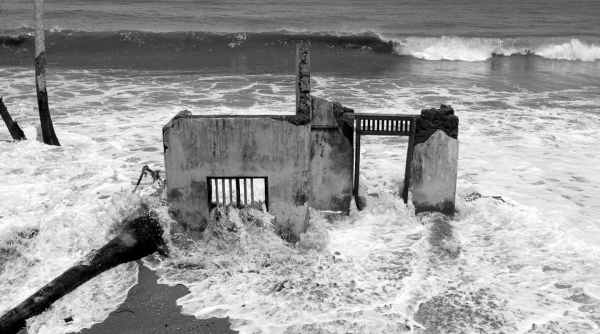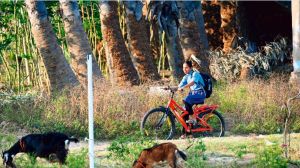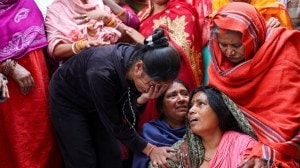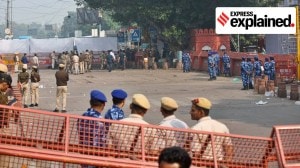Riders to the sea: Why an Adani port adds to worry of the coastal community
The fear is of the end of a lifestyle, community, traditions, culture, a world that provided them both autonomy and agency despite being at the receiving end of sea rage
 A Chavittunatakam artist -- storyteller of the seashore. (Photo: K R Sunil)
A Chavittunatakam artist -- storyteller of the seashore. (Photo: K R Sunil) “There are three sorts of people: those who are alive, those who are dead, and those who are at sea” – an ancient saying.
Sometime in 2015, Kerala-based photographer K R Sunil started to document the men who used to work as crew members on traditional seafaring vessels called Uru. One of them, when asked to describe the sea, said, “Sea, it is a boiling vessel (Kadal oru thilakkunna chembanu)”. The vessel he meant was the utensil generally used to cook food items such as biryani.

Artist Riyas Komu has curated a remarkable exhibition, Sea: A boiling vessel, which is currently on view at Hallegua House in Fort Kochi. Sunil’s photographic series on Chavittunatakam artists is part of the exhibition. Chavittunatakam is an art form that originated among the fisherfolk native to Kochi and its neighbourhood in the 16-17th century. It shows Portuguese influence and the performances draw their themes from Christian mythology and folklore. The performers have always been men from the fishing communities.
However, the grand role the artists essay on the stage – for instance, the life of the Roman emperor Charlemagne — are in sharp contrast to their penurious real life. Sunil’s poignant photographs frame these artists, mostly fish workers, against their bare homes that are constantly under threat from erosion or sea ingress during the monsoon. The precarity of their lives — professional as well as personal — is representative of a large number of people who are dependent on the sea for their livelihood.
 To the north of the port town, the coast has seen major erosion with the sea swallowing hundreds of homes and beaches. (Photo: K R Sunil)
To the north of the port town, the coast has seen major erosion with the sea swallowing hundreds of homes and beaches. (Photo: K R Sunil)
The metaphor of the sea as a boiling vessel is pregnant with meaning. It evokes both the turbulence visible on the surface as well as the turbulence in the inner lives of seafaring communities. In recent times, the people living on the coast and living off the sea have also been on the boil, caught in the whirl of climate change and the churn in the coastal political economy. Kerala’s coast is today frequented by storms and cyclones, unusual to the region, and wrecked by erosion. In the southern tip of the state, an Adani port-project has produced its own storm with the local fishing community, bearing the brunt of a depletion of catch, now alarmed by construction activities that they believe would annihilate livelihoods.
It has pitted the coast against the hinterland, the coastal communities against the political class that seem to be invested in the project in the hope that it could rejuvenate the state’s debt-ridden economy and launch it towards an orbit of growth. The coastal villages have been promised that the port economy will change their lives for the better, which many, initially, had bought into. For people living in the hinterland, mainly in and around the state capital of Thiruvananthapuram, the port is seen as the promise of “development” that will usher in better land prices and jobs. Questions though have been asked if all the projected traffic in ships and cargo are for real and at what cost to the environment.
The big picture story of hope and development has little space for micro narratives of people whose very existence as a community seems to be under threat. However, for perspective, keep this number in mind: The fisherfolk population in Kerala is about 10.5 lakh and there are over three lakh people registered as fish workers. A church leader mentioned that there are over 60,000 fishermen in the neighbourhood of Vizhinjam, where the Adani group is constructing a Rs 7,700-crore port on design, build, operate basis for the Kerala government. To the north of the port town, the coast has seen major erosion with the sea swallowing hundreds of homes and beaches. Meanwhile, sand has been deposited on the shore to the south of Vizhinjam.
Last year, work at the project site was stalled for 156 days when the local population hit the streets demanding that the government clear their concerns before pushing ahead with the port project. Since the Church is the pivotal point for the fishing communities, the leadership of the agitation naturally fell on the clergy. That prompted a section of the political class and the media to paint the public action in communal colours. The agitation was called off in December after the government agreed to a seven-point demand put forth by the protestors. Among the demands were an intensive environment impact study and a better rehabilitation package.
That 275 families, whose homes were lost to the sea, continue to be lodged in cement godowns for years seem to have caused public distrust and scepticism in the state’s promise that project-displaced people would be properly rehabilitated. Besides, Cyclone Ockhi and Covid had already devastated the economic fabric of the region. Community leaders ask would fishing be possible if their coast becomes a busy shipping channel.
This is an apprehension the fisherfolk in Kudankulam had raised when they protested against the setting up of a nuclear power plant in their backyard a decade ago. A container and transhipment harbour project proposed in Enayam, near Kanyakumari, ahead of the 2019 general election had triggered protests from local communities.
In fact, the Kerala coast has a history of direct action dating back to the 1980s, when Father Thomas Kochery, a priest shaped by the radical Liberation Theology, and others formed the Kerala Swatantra Matsya Thozhilali Federation (KSMTF). What started as small sit-ins in 1981 became a major protest in 1984 when Sister Alice in Kozhikode and Sister Philomena Mary in Thiruvananthapuram led hunger strikes demanding a ban on trawlers during the monsoon months. It led to the enactment of a law (the Kerala Marine Fishing Regulation Act) against trawling during monsoon as well as fishing by large vessels in a 22-km vicinity of the coast. Father Kochery was instrumental in the formation of the National Fish Workers’ Forum also.
In 1989, two marches were held – one led by Fr Kochery from Kolkata and another by Mathai Saldana from Gujarat — to Kanyakumari raising the slogan ‘Protect Waters, Protect Life’. Thousands congregated at the Cape on May Day 1989, which was on the boil following the news that a nuclear plant was to come up in Kudankulam. Police fired upon the marchers and two persons died. These mobilisations were the earliest by trade unions demanding ecological audit of economic activities. If they spoke for artisanal fishers and the rights of boat workers in the late 1970s and early ’80s, the unions educated fishing communities to assert their right over resources, in this case the coast and sea water. The impulse for mobilisation was economic, of course, but it did not ignore the necessity to be sensitive to the environment. The idea of sustainable fishing was integral to unionisation. The sense of solidarity nurtured by the legacy of collective action was also instrumental in fish workers moving into the hinterland to undertake rescue work during the massive 2018 floods.
Clearly, the idea of developing the coast has different meanings for different communities. And, it is not just about compensation and employment. A large number of the youth have already acquired education and moved on to white collar jobs. Many have joined seafaring professions, such as working on merchant navy vessels. The fear is of the end of a lifestyle, community, traditions, culture, a world that provided them both autonomy and agency despite being at the receiving end of sea rage. The seashore is a world within itself, an open communal space where happiness and sorrows are shared; banter, gossip and music exchanged. It lets one immerse in the crowd and allows one to pursue solitude. It’s this world that is under threat from “development”.
The state, driven by the cold logic of economics, may wish to enclose the coast and turn it into an internal colony of the hinterland. That, however, is likely to be met with resistance. Such resistance is not anti-national by any stretch.






- 01
- 02
- 03
- 04
- 05

























